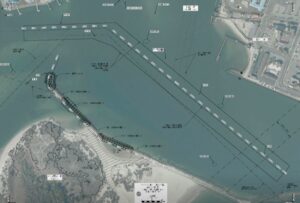
SNOW HILL – A representative from the U.S. Army Corps of Engineers outlined reasoning behind plans to continue maintenance dredging to address shoaling in Ocean City.
Daniel Bierly, chief of the civil project development branch for the U.S. Army Corps of Engineers (USACE), told the Worcester County Commissioners this week the high cost and minimal effectiveness of a structural solution to shoaling prompted the agency to abandon that plan. Instead, the channel will continue to be dredged twice a year.
“What we found is that even with that solution, we really didn’t reduce the need for dredging very much,” Bierly said. “That’s the long and short of it.”
Upon learning earlier this spring that the USACE was no longer pursuing plans for a long-term structural solution to address the navigation issues near the Inlet, the commissioners reached out to the agency to seek more information. Bierly attended this week’s meeting to elaborate on what led to the decision.
“I want to focus really on what we do going forward,” he said. “The Corps is dedicated to maintaining this channel.”
He said it was the agency’s mission to maintain its channels.
“The question is how do we do that such that the commercial and recreational users can continue to use this channel,” he said.
Bierly explained that the area was fortunate that the USACE had two dredges of its own, the Currituck and the Murden, to maintain the waterway. While that sort of work would typically be contracted out, he said the USACE had purchased the dredges because shallow water hopper dredges aren’t readily available in the private sector. The ships stay busy all year working along the East Coast and Gulf Coast.
“They come to Assateague Island twice a year,” Bierly said.
Because concerns have been raised in recent years regarding the increasingly shallow depth of the channel, the USACE began exploring design of a structural solution that would reduce the need for dredging and address shoaling. When the Corps realized the solution that had been designed wouldn’t significantly reduce the need for dredging, officials opted not to proceed.
“The Inlet is an extremely dynamic area,” Bierly said. “The material not only comes in at the Inlet but also across the back bays. It’s very difficult to know what to do. This solution just didn’t pan out plus it’s extremely expensive. It’s over $16 million for that solution.”
Bierly reviewed annual dredging figures and suggested more dredging could be an option but would be difficult because of how busy the dredges were.
“Their schedule’s very constraining,” he said.
Rather than an increase in the frequency of the dredging, Bierly believes an increase in the volume could prove helpful.
“I think we should give it a try, see if it works,” he said. “It can’t be worse.”
Commissioner Eric Fiori said that as a Jet Ski dealer he was familiar with local waterways and had noticed changes southeast of the Inlet.
“In the center of that shoal it’s gone from 9-12 feet to as shallow as 3 in other areas,” he said.
Bierly said that was an interesting observation and one he’d take back to his associates at USACE.
Commissioners Jim Bunting and Joe Mitrecic echoed Fiori’s concern. Mitrecic added that the concept of dredging deeper had been discussed multiple times. He wants to see the issue addressed before it impacts boater safety. He said maybe the channel needed to be dredged deeper and the material taken farther away.
“Time is money. Distance is money,” Bierly said, adding that taking the material even a little farther would increase the cost tremendously.
Commissioner Chip Bertino asked how the county could help ensure navigation improvements were made.
“The more voices you get saying something the easier it is,” Bierly said.
The commissioners agreed to send a letter to the USACE reiterating their concerns and seeking more dredging to help reduce shoaling.

